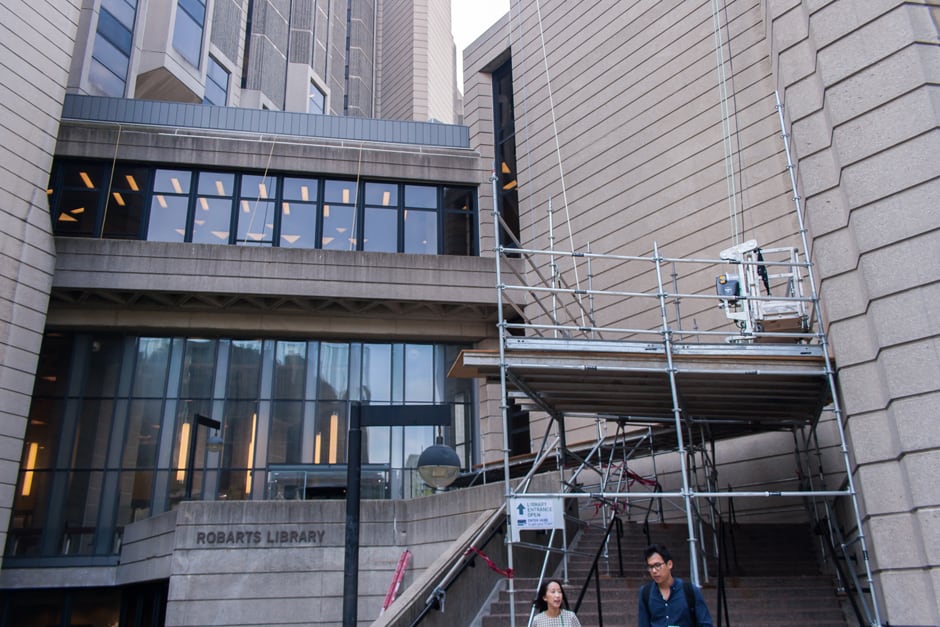According to a recent Sightlines study of deferred maintenance of Canadian universities, commissioned by the Canadian Association of University Business Officers, building age profiles and enrolment growth contribute most to deferred maintenance on Canadian campuses.
Last January, the University of Toronto released its deferred maintenance report for 2013. According to the report, the university faced a total deferred maintenance cost of $505 million last year.
“While this year’s figures have yet to be determined, research facilities, such as the Medical Science Building are complex to build, maintain, operate, and retrofit. They do, therefore, tend to contribute a larger share to the overall deferred maintenance … liability than less complex buildings, such as office buildings and residences,” said Ron Swail, assistant vice-president, facilities and services.
Swail added that the increase in deferred maintenace liability largely stems from auditing procedures that produce more detailed reporting, inflated costs, newer campus buildings — including acquisition of older buildings — and the collective aging of the buildings.
The Sightlines database identified 1960–1975 as an era when a large number of new constructions occurred at universities to accommodate an influx of new students. The top five U of T buildings that require priority deferred maintenance attention were constructed during this era. Four of the buildings also contain significant asbestos fireproofing, a fibrous mineral that requires prompt repair and removal should the buildings deteriorate, in order to prevent health risks.
Much of Ontario’s deferred maintenance is caused by enrollment growth outpacing space available on campus. The report said that Ontario institutions have experienced enrollment growth over 15 per cent, while the increase in campus space is less than 10 per cent over the same time period. This caused the wear and tear on campus spaces to increase and impacted future maintenance requirements.
“The expansion of campus size does affect deferred maintenance liability. While a new building typically does not have deferred maintenance until after the seventh year, older buildings newly acquired by the university often come with their own deferred maintenance,” added Swail.
Swail confirmed that the university will invest $14 million of internal funding, plus money from the Facilities Renewal Program, to combat deferred maintenance issues. Around $2.4 million will be invested in the St. George campus directly.
“Beyond this direct funding, the issue of deferred maintenance will also be addressed through capital projects. Other building retrofits completed by departments will also contribute to the issue,” added Swail.
However, according to Graeme Stewart, communications manager of the Ontario Confederation of University Faculty Associations, a clear cause of deferred maintenance is the chronic provincial underfunding of universities. The total funding for public universities last year was just under $3.5 billion, but total deferred maintenace debt was around $2.6 million. “We interpret these results to mean that the under-funding continues to impair the ability of our universities to renew and repair their facilities,” said Stewart.
The Sightlines report suggested setting capital priorities, replacing aging space with new modern facilities, keeping up with building life cycles, and matching new construction with future program needs.
“We are using many of the strategies noted in the report,” said Swail, adding: “The university only builds what it needs and sets a rigorous system to validate new buildings. Our ongoing priority-setting addresses the criteria of priority repairs, major renovations, enforcement agency orders and academic priorities. Our design standards for new buildings also ensures lower maintenance needs and fewer capital renewals.”
Ontario recently pledged $500 million over 10 years to address the issue of deferred maintenance and increase post-secondary enrollment by 15,000 students. “[Facilities Renewal Program] funding will increase significantly over the next few years,” said Linda Mackay, manager of issues and media relations at the Ministry of Training, Colleges and Universities.
“Major capital funding is project-specific, and the amount of funding received by any university would be based on the objectives of each capital program,” she added.


